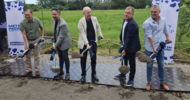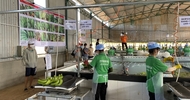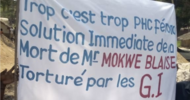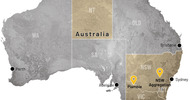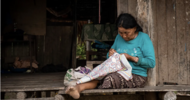Panama Papers: Elusive beneficiaries of Mozambique’s $4.2bn agricultural deal uncovered
Despite claims that a massive agricultural development deal in Mozambique will benefit the country’s citizens, there are indications that the project is designed to benefit a select few and could leave 100,000 Mozambicans displaced, write Khadija Sharife, Luis Nhachote
When Mozambique’s civil war ended in 1992, external finances began to re-enter the country. Foreign investors were attracted to the opportunities presented by mines, game reserves, islands and oil and gas deposits. Now, international financiers have tapped into a new opportunity: farmland. Particularly, arable land in northern Mozambique’s Nacala Corridor.
More than 95% of Mozambique’s cultivated land is worked by millions of families that farm for food and income. But the land and its people may be at risk if one of the largest agricultural development deals in Africa is realised. Details leaked from the Panama Papers database show that the Lurio River Valley Development Project, which is valued at $4.2 billion, is being orchestrated behind a web of opaque offshore companies with little in the way of credible track records, financing information, ownership information or even brick-and-mortar offices.
A leaked copy of a corporate presentation from 2014 identifies 240,000ha of land for development along the banks of the fertile Lurio River, and spanning three provinces – Cabo Delgado (18%), Niassa (25%) and Nampula (57%). The project aims to develop large private industrial farms, dams and other infrastructure like canals. An estimated 500,000 people inhabit these lands and may be impacted if the project goes ahead without adequate consultation. Critics agree that it is infrastructure a country like Mozambique desperately needs, but have enough serious questions about the project’s details been asked, including: Who is served by the design of infrastructure? Who is behind the project? And who are the true beneficiaries?
Ownership Web
According to the leaked document, a company called Companhia de Desenvolvimento do Vale do Rio Lúrio (DVRL) leads the project, and despite the size of the deal, little information about the the company is available, other than that DVRL is managed by two financial entities: Turconsult and Agricane. The latter says it provides consulting services to large-scale farmers and has offices in South Africa and Malta, a European tax haven. No telephone numbers are listed for Agricane and only one general email address is provided. Turconsult is headed by Rui Monteiro, an influential Mozambican businessman with alleged high-level connections to Mozambique’s ruling Frelimo Party. Monteiro’s LinkedIn profile shows him to be the Mozambican representative of Rani Resorts, owned by Sheikh Adel Aujan, a financier connected to significant Gulf investors. Aujan is considered the king of luxury tourism in Mozambique. Much of Rani’s tourism empire is based in and around the Nacala corridor, including private islands, spas, resorts, five star hotels, glamorous wilderness camps and lucrative real estate holdings. Researches say Monteiro is a key local “fixer” who guides investors through the implementation process of projects, including assistance with regulatory and policy systems.
In an email exchange, Monteiro declined to respond, deferring to another company, Arcem, for answers. Formerly Arcadia Energy and Mining, Arcem’s listed Mauritian address also corresponds to dozens of other mining entities listed in the Panama Papers database, such as Arcadia Coal, Arcadia E&P, International Exploration Mining Company (IEMC), Great Lakes Minerals and others.
This corresponds to reports in Mozambique’s Business Gazette, which indicated that in December 2015, Arcadia Agricane Limited, a Mauritian-based entity, acquired 98% of shares in DVRL. The remaining 2% was held by Rui Monteiro. Arcadia was then renamed Lurio Valley Limited. These shares were purchased from another Mauritian company called Arcem Resources.
Arcem
Though Arcem claims to be a “natural resource-based investment company” with 20 years’ of experience, little substantive or credible information could be found related to mining being its principal activity, or to other business involving agriculture and infrastructure.
The Panama Papers database shows a web of shell entities connected to Arcem, including Great Lakes and IEMC, which shared a Mauritanian address with Arcem. It also reveals a revolving door of corporate shareholders that appear to be shell entities or nominees with no substantial economic activities and no identifiable beneficial owners. Shareholders such as Trillion Resources, Broadway Holdings, Read International and RP Foster are all based in the British Virgin Islands, the Bahamas and Guernsey, among other tax havens.
Information about the Arcem group involving Arcem Resources shows South African Paul Main to be the director; Maitland, a Mauritius-based corporation, one of the consistent nominee management companies; and the Highlands Trust as the ultimate beneficial owner.
In response to questions sent to Turconsult, a representative from Arcem, with Agricane’s Chris Matthews and Turconsult’s Monteiro copied in, stated: “Arcem is a private company and one of the project initiators, together with Agricane. Arcem is interested in participating in the infrastructure aspects of the development through one of its subsidiar[ies] and currently has a minority shareholding in the proposed development company. The final shareholding of DVRL will be determined by the financial contribution once the development commences.”
Confidential data appears to show that the Lurio Valley Development Project’s beneficial owners include Mauritian-based Agri-Pemba and Agricane Commercial Holdings, along with the Highlands Trust and Arcadia Energy and Mining. This was neither confirmed nor denied by Arcem.
Turconsult’s role was described by Arcem as a “project advisor coordinating the consultative and approval process”.
Arcem’s representative confirmed that two phases, an initial study and a consultative process, had been completed, and that the project was currently in the third phase. The third phase is a licensing and detailed study phase that needs to be completed before the project can roll out, and which is expected to take place over a period of approximately 15 years. While Arcem denied any government approvals had taken place, project details show that a signed memorandum of understanding (MoU) for land and water use was concluded in 2012 following presentations to ministers, governors and administrators.
Arcem is not formally listed on the leaked document as a participating entity. In its responses, Arcem indicated that comments being made were on behalf of the project, and not Arcem itself. Neither Monteiro nor Agricane responded to questions.
From Abu Dhabi to South Africa
A company called Exeed is listed as a key interested funder for the dam segment of the project. Exeed is part of National Holdings, a private company belonging to the Royal Family of Abu Dhabi. Kamel Abdallah, the CEO of Exeed, was previously the head of Rani Investment and the executive vice chairman of Aujan Industries. Arcem said that funders were still to be formalised but that Exeed could play a role, depending on the approval process and the final studies. Arcem’s representative also denied that the Aujan family had any interest in the project. However, there have been suggestions that the funding for a dam was a trade-off in exchange for access to prime land and water which the Gulf needs.
Arcem’s representative also said that the Highlands Trust, the beneficial owner of Arcem, was a private family not connected to Mozambique. The Panama Papers database shows the Highlands Trust to be a Jersey-incorporated entity that is represented by Church Street Trustees whose purpose was listed as “places of worship”.
Highlands Trust receives monies loaned from a British Virgin Islands-based company called Termic, whose shareholders are Highlands Trust and a South African family, the Stewarts. The funds are loaned at a 0.25% interest rate, a favorable rate likely indicating that the companies are part of the same structure. According to the agreements, Termic’s loans were intended for a mining entity, Gem Diamonds (incorporated in the British Virgin Islands), which is a majority shareholder of Lesotho’s Letseng diamond mine.
Sources inside Arcem claim that its beneficiary is not the Jersey-based Highlands Trust but another, unrelated, Highlands Trust. Gem Diamonds denied the existence of the Termic loan agreement and claimed they had no relation to Highlands Trust.
In South Africa, Main’s checkered history includes playing a role in a contentious corporate scandal involving JCI and Randgold.
In 2006, JCI sold its shares in Letseng to Gem Diamonds. Court documents show that Main was also connected to the conceptualisation of Letseng’s Guernsey entity prior to the Gem Diamonds purchase.
100,000 Displaced
Despite the unclear funding sources and opaque company structures, Arcem’s leaders are at least paying lip service to the people who live in the Nacala Corridor. In response to an emailed interview, Arcem said that while the project was very much in its nascent stages, “the Community is an important participant in the project and will only benefit from this development. We have emphasised this in all presentations and through the consultative process.”
Figures provided by local Mozambican civil society organisations such as Acção Académica para o Desenvolvimento das Comunidades Rurais (ADECRU), and derived from official sources such as the National Bureau of Statistics, indicate that around 100,000 people will be displaced by the project. ADECRU’s Vicente Adriano explains that in researching this figure, ADECRU included the total number of households living along the Lurio River in listed districts across the three provinces, factoring in a margin of error at 5%. Adriano said: “there wasn’t any kind of consultation with local communities. Some of the local authorities have never even heard about this project … or at the local or national level.”
But investors that have kept an eye on the project claim these figures are inflated. Arcem itself stated the project was in early stages and that no government approval had yet been granted.
Both civil society and investors spoke of the critical role played by the Lurio River as a source of fertile land and water.
Arcem clarified that while Agricane brought the requisite agricultural experience to the table overall, it was primarily intended as an infrastructure project. However, a company document from November 2015, indicates that the project had expanded its targeted area for agricultural development from 240,000ha to 600,000ha, and had applied for land use permits (DUATs) covering 347,528ha in Nampula, 107,117ha in Cabo Delgado and 152,591ha in Niassa – rendering it the largest agricultural development project in Africa. An MoU for land and water use apparently already approved by the government could not be sourced. Mozambican Minister of Agriculture Jose Pacheco and his press adviser, Ines Catine could not be reached for comment at the time of publication.
Though Arcem confirmed the consultative process had been completed, the company declined to expand on what a full consultative process actually entailed, or which communities had participated in it.
Though the project was privately presented to the Mozambican Council of Ministers in 2015, it appears the government has yet to formally comment on the deal.
Critics have asked how the government approved an MoU when information such as track record, capacity and credibility of the companies, as well as investor details, like beneficial owners, were not transparent. Foreign investors unrelated to the project claimed that it was part of the normal process and not unusual. “How could Mozambique suffer for getting a new road or a dam for electricity? Who will bring it otherwise?” said one investor who asked to have his name withheld.
When asked whether the government could negotiate resettlement of citizens, a local activist said: “even with 1,000 hectares of land involved, there has been much conflict.” He added that despite the existence of laws recognising the customary and administrative rights of communities, the biggest problem with the Lurio project is conflict of interest.
This view is supported by Adriano, who said: “Most investment has the direct involvement of government people and important figures of the Frelimo party. We have individuals that are simultaneously politicians, businessmen and government officials.”
This story was produced by the Verdade newsroom, together with the African Network of Centers for Investigative Reporting and the International Consortium of Investigative Journalists.






